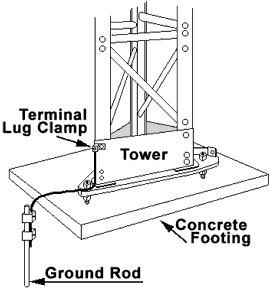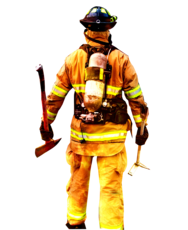You may have a mechanical ground, but do you have an electrical ground?
You may have a mechanical ground, but do you have an electrical ground?
The lightning rod is clamped to the highest point on the mast. The ground wire is connected to the lightning rod and should be one continuous piece all the way to the earth ground rod. A small loop is left just above the thrust  bearing to allow the mast to rotate. If you cannot use a lightning rod point because of the antenna, tape or wire tie the ground wire to the mast as far up as practical.
bearing to allow the mast to rotate. If you cannot use a lightning rod point because of the antenna, tape or wire tie the ground wire to the mast as far up as practical.  This will provide some lightning protection to other components such as rotators, antennas, etc. When using a Hazer, the ground wire runs down the messenger line, and into the ground rod system. This can provide the electrical ground required for long wire antennas. With rooftop towers, the ground wire should run f-rom the tip of the mast, be connected to the tower, and then run all the way to the ground. Grounding the tower cannot be over stressed. Local or national codes should be complied with. The head of the ground rod should be driven at least 6 inches below ground level and the ground wire should be attached with two GR-4400 ground rod clamps. Ground your system to achieve a goal of 25 ohms or less ground resistance. Additional ground rods may be necessary to accomplish this. The ground cable, 4 AWG by 19 strand bare copper is very flexible and is ordered separately. It is advisable to consult with an experienced lightning professional for installation.
This will provide some lightning protection to other components such as rotators, antennas, etc. When using a Hazer, the ground wire runs down the messenger line, and into the ground rod system. This can provide the electrical ground required for long wire antennas. With rooftop towers, the ground wire should run f-rom the tip of the mast, be connected to the tower, and then run all the way to the ground. Grounding the tower cannot be over stressed. Local or national codes should be complied with. The head of the ground rod should be driven at least 6 inches below ground level and the ground wire should be attached with two GR-4400 ground rod clamps. Ground your system to achieve a goal of 25 ohms or less ground resistance. Additional ground rods may be necessary to accomplish this. The ground cable, 4 AWG by 19 strand bare copper is very flexible and is ordered separately. It is advisable to consult with an experienced lightning professional for installation.


 bearing to allow the mast to rotate. If you cannot use a lightning rod point because of the antenna, tape or wire tie the ground wire to the mast as far up as practical.
bearing to allow the mast to rotate. If you cannot use a lightning rod point because of the antenna, tape or wire tie the ground wire to the mast as far up as practical.  This will provide some lightning protection to other components such as rotators, antennas, etc. When using a
This will provide some lightning protection to other components such as rotators, antennas, etc. When using a 